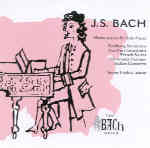Good as it is to have these long-out-of-print performances reissued for the first time, Vanguard does their potential audience a major disservice by including no biographical nor contextual information whatsoever about the pianist. Born in Scotland, James Friskin (1886-1967) settled in the U.S. in 1914 and was an original faculty member of the Juilliard School, where he taught until his death. His editions of Bach’s music were highly regarded for pedagogical purposes, and he similarly gained renown for his own Bach pianism. Nearing his 70th birthday, Friskin recorded a series of three Bach LPs in 1954 and followed up with the Goldberg Variations two years later. Compared to the two Bach pianists who dominated in the 1950s (Tureck and Gould), Friskin clearly is a player of his generation. He makes discreet use of the sustain pedal; he often rounds off phrase endings and brings a movement to its conclusion by way of gradual ritardandos; and he uses repeats as an opportunity to change color and dynamics or bring out inner voices (he’s rather cavalier about which repeats he observes and omits). Occasional octave doublings and filled-out textures also have a foot in the 19th-century. Yet all this is done with the utmost in musicality and good taste, and it wouldn’t be far off the mark to call Friskin “a Romantic with brains” (to paraphrase Harold C. Schoenberg’s apt description of Artur Schnabel). What’s more, Friskin’s finger work is (for the most part) clean and characterful, abetted by a tone that always sings and by an instinctive rather than overly worked-out way of balancing polyphony.
These qualities particularly come home to roost in the French Suites and in the Two-Part Inventions. I especially like his crisp and assured readings of the B minor suite, the D minor, F major, and A major inventions, and the B-flat invention’s gorgeously gauged “question-and-answer” interplay between the hands. The Goldberg Variations also contain many wonderful moments: No. 11’s inner rhythm, No. 13’s vocally inspired eloquence, a refreshingly “un-etude-like” reading of No. 23’s double notes, and an unusual approach to No. 18, where the canonic voices are scaled down in favor of the jaunty left-hand line. Sometimes Friskin’s fingers get tangled up in the cross-handed movements (No. 26 is frankly labored), but you always hear what he wants to do (and can do, 98 percent of the time).
Friskin’s intimate, improvisatory shaping of the Chromatic Fantasy and Fugue differs from the steely bravura of Rudolf Serkin’s 1950 Prades recording. By contrast, the Italian Concerto’s outer movements are heavy and square as Friskin plays them, and they don’t match his best work throughout this collection. The transfers accurately reflect the original LPs’ excellent sound quality, although occasional instances of tape noise, wow, and flutter suggest that all is not well with the source material. Let’s hope Vanguard will soon rescue from oblivion its remaining Bach Friskin titles: the B-flat Capriccio, C minor Toccata, A minor Fantasia and Fugue, A minor Fantasia and Double Fugue, C minor Fantasia, and Friskin’s transcription of the Chorale Prelude O Mensch bewein.
































